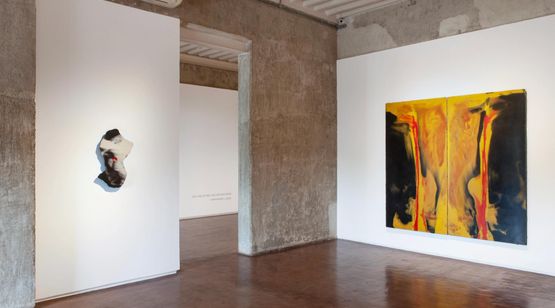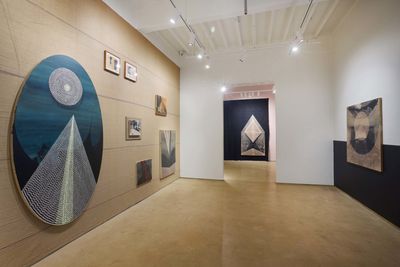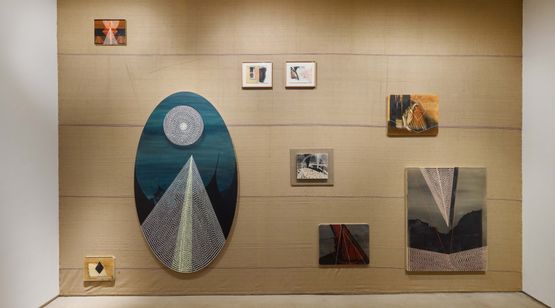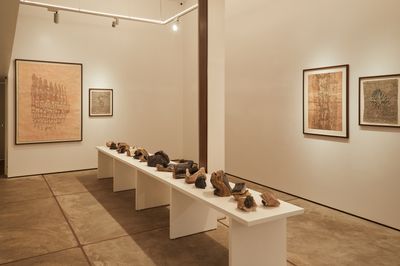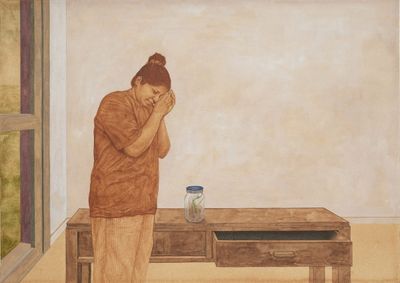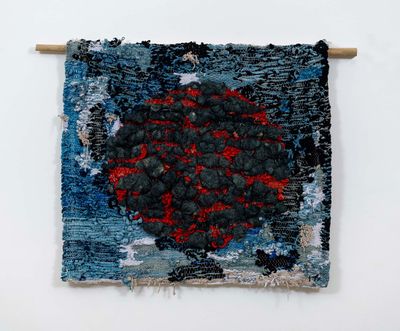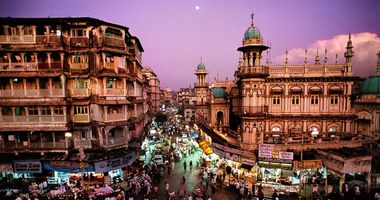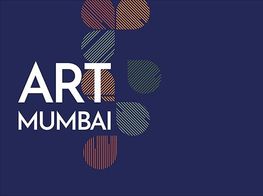5 Must-See Shows During Art Mumbai 2023
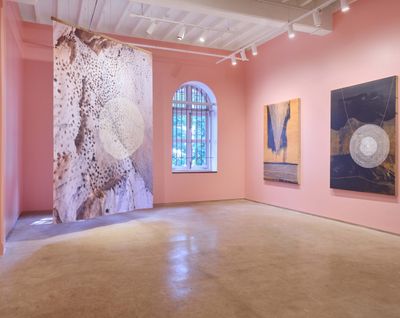
Exhibition view: Radhika Khimji, Cutting Into Space, Experimenter – Colaba, Mumbai (9 November–23 December 2023). Courtesy Experimenter. Photo: Abner Fernandes.
Mumbai's first contemporary art fair, Art Mumbai, arrives at Mahalaxmi Racecourse from 16 to 19 November. Conceived as a test-run, this first edition includes 50 galleries with the majority based in India.
With the advent of the fair in India's most populous city, we share five must-see exhibitions at Mumbai's galleries including cosmic abstract paintings by Harminder Judge at Jhaveri Contemporary and striking mixed-media works by Radhika Khimji at Experimenter.
Harminder Judge: Sea and Stone and Rib and Bone
Jhaveri Contemporary, 4 Merewether Road
9 November–23 December 2023
Expect: bright torrents that open into cosmic reflection, taking after the geometries and spirituality of neo-tantric painting.
Aligned with Indian neo-tantric art and Abstract Expressionism, Harminder Judge's paintings are conceived as portals into spiritual contemplation. They combine an interest in Indian mysticism, folklore, and colour-field painting to transport viewers through subconscious geometries.
The diptych Untitled (shoot through the soil) (2023) presents two columns of molten lava dripping from a blue rock-like formations on mirroring panels. Though they appear symmetrical from afar, a closer look reveals idiosyncrasies on either side, recalling the form of a Rorschach inkblot test.
Neo-tantric art followed the Tantric revival in India in the 1960s and 1970s, a movement within Hinduism which believed in the interconnectedness of the self and the world. Artists working with its astrological elements, calligraphic forms, and geometric diagrams saw it as a form of modernism, in parallel to 20th-century movements that emerged in the West.
Radhika Khimji: Cutting Into Space
Experimenter, 16/18 Merewether Road
9 November–23 December 2023
Expect: striking large-scale paintings that overlap formal elements and diverse media to prompt a closer look.
Oman-born artist Radhika Khimji presents new works that continue her exploration of the liminal space between landscape and body. Using overlapping elements and mediums, Khimji encourages viewers to look beyond categories.
Intricate compositions emerge as a result, as seen in Make of me a steeple (2023), a house-shaped painting on birch plywood, made of oil and gesso on photo transfer. An abstracted, monochromatic landscape is painted over with triangles and circles of varying densities, allowing a partial view of the underlying image.
Through her works, Khimji encourages viewers to think through shapes, geometries, and the body. Different temporalities appear to emerge from the combination of photographic medium's rapid capture and the slower mark-making of hand-painted surfaces.
Savia Mahajan: Amino Soup
TARQ, 39 AK Nayak Marg
12 October–30 December 2023
Expect: ink drawings and organic textured vessels that dive into material transformation.
Following presentations at the Indian Ceramics Triennale and Jaipur's Sculpture Park at Madhavendra Palace in 2019, Mumbai-based sculptor Savia Mahajan continues to explore her interest in materiality and themes of resurgence with a new series of mixed-media sculptures in her second solo exhibition with TARQ.
In the exhibition's accompanying text, poet and critic Ranjit Hoskote wrote: 'Monocultural notions of formal, conceptual and material purity have no place in [Mahajan]'s world-view', adding that Mahaja characterises clay as a carrier of energy from material to object, and object to viewer.
In Amino Soup, Mahajan presents 'ceramic books' in which fire and rocks are used to symbolise external pressures. Taking the shape of unworked stone, Organic forms such as Pietra 9 (2022) combine paper and clay, which is then shaped by throwing or fitting foraged rocks gathered from the artist's travels across Rajasthan, Bhuj, and the Konkan region.
In Mahajan's 'Emergency old longing' series (2022–2023), sculpture becomes a metaphor for exploring how objects are forced out of inertia through alchemical transformation. Left colourless or incorporating rust to create burnt red-brown tones, these textured mounds of porcelain, paper, thread, and mother of pearl reflect an urgency to move from one material state to the next.
Mrudula Kunatharaju: Possibility of an Otherwise
APRE Art House, Plot no. 28, Sanghvi House, 3rd Pasta Lane
9 November 2023–2 January 2024
Expect: confessional memoir across new works on paper, moving image, and experimental sculptures that centre strong feminine narratives.
Mrudula Kunatharaju explores her interest in genealogy and societal expectations of women through self-portraiture. These often result in mysterious depictions that isolate the artist's body within minimal domestic spaces and abstract, distorted environments.
In 'Not Just One Afternoon' (2021), Kunatharaju's seven-part drawing series on tea-toned paper, faint outlines of the artist's body can be seen beneath the simplified white outlines of a minimal brick house. Across the drawings, the figure is seen to sit or lie in bed, with the sixth work in the series showing the collapse of the house's four walls.
In other works, Kunatharaju appears in various poses: seated while holding her own sculptures; blindfolded; collapsed on the ground; or weeding in the garden. Her largely domestic surroundings are depicted in simplified detail, centring her experience with a detached confessional mood. In this way, Kunatharaju scrutinises a patriarchal voyeurism.
Moumita Das: Depth Charge
Chatterjee & Lal, 01/18 Kamal Mansion, Arthur Bunder Road
9 November–28 December 2023
Expect: subversive textiles that pay homage to abstraction, technical drawing, weaving, and domestic labour.
There is a violence in the textile works of Moumita Das, which commonly present abstracted bodies and 'wounds' within tapestries and knitted surfaces with soft appearances. Even in seemingly peaceful scene of a sunset at Shantiniketan, blood-red fibres contrast starkly against the blues of the sky. Das has described her work as capturing forms of civic strife—'an outside cannibalising an inside,' as Kedar A. Kulkarni wrote.
Often inspired by nature, Das' tapestries are made using a range of techniques from crochet to threadwork, vegetable dying, and appliqué. Rough textures are created from fibre blends including wool, hemp, jute, and cotton. Though in her formative years she expressed little interest in such feminised art forms, Das eventually took up her mother's offer to teach her to crochet.
The juxtaposition of natural materials and jarring textures and subjects highlights the artist's methodical interpretation of her environment. In Structured Wounds In Nature (2022)—a composition of woven tapestry and Kalamkari, a type of hand-painted cotton textile—an abstracted wound form assumes a uniformity, unfolding layers of flesh and blood through natural dyes and pigment. —[O]


